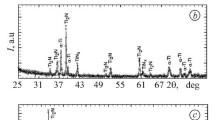Abstract
The time dependence of the potential difference that appears between two VT6 titanium alloy plates separated by a mixture of epoxy resin with an epoxy hardener is studied. One of the plates is placed in epoxy resin until equilibrium is established, and the second plate is coated with an as-prepared mixture of epoxy resin and a hardener. It is found that the potential difference decreases in time because of charge transfer by Ti2+ ions through epoxy resin. Photoluminescence and infrared absorption spectra of epoxy adhesive on the VT6 alloy surface are recorded. Their analysis shows that the Ti2+ ions having penetrated into the as-prepared mixture of epoxy resin and a hardener interact with CN groups in adhesive molecules to form coordination compounds. As a result, a diffusion layer saturated with coordination compounds forms at the alloy/adhesive interface, which leads to an increase in the strength of the adhesive.
Similar content being viewed by others
References
I. A. Starostina and O. V. Stoyanov, Acid-Base Interactions and Adhesion in Metal-Polymeric Systems (KGTU, Kazan’, 2010).
T. Semoto, Y. Tsuji, and K. Yoshizawa, Bull. Chem. Soc. Jpn. 85, 672 (2012).
He Peigang, Ke Chen, Bin Yu, Chee Yoon Yue, and Jinglei Yang, Compos. Sci. Technol. 82, 15 (2013).
V. I. Vettegren’, A. Ya. Bashkarev, and V. A. Sytov, Tech. Phys. Lett. 30, 99 (2004).
V. A. Sytov, V. V. Sytov, and V. I. Vettegren’, Izv. St. Petersb. Gos. Tekh. Inst., No. 21(47), 102 (2013).
K. S. Krasnov, N. K. Vorob’ev, I. N. Godnev, V. P. Va- sil’eva, V. P. Vasil’ev, V. L. Kiseleva, K. N. Belonogov, and V. P. Gostikin, Physical Chemistry, Vol. 2: Electrochemistry. Chemical Kinetics and Catalysis (Vysshaya Shkola, Moscow, 2001).
V. V. Skorchelleti, Theoretical Electrochemistry (Goskhimizdat, Leningrad, 1959).
J. L. Crossland and D. R. Tyler, Coord. Chem. Rev. 254, 1883 (2010).
I. Hamerton, B. J. Howli, and P. Jepson, Coord. Chem. Rev. 224, 67 (2002).
R. H. Crabtree, The Organometallic Chemistry of the Transition Metals (Wiley, Yale New Haven, 2005).
V. I. Vettegren’, R. I. Mamalimov, A. V. Savitskii, I. P. Shcherbakov, V. V. Sytov, and V. A. Sytov, Tech. Phys. 59, 441 (2014).
O. Madelung, Festkorpertheorie (Springer, Berlin, 1972).
V. I. Vettegren’ and I. I. Novak, Sov. Phys. Solid State 15, 957 (1973).
Grades of Steel and Alloys. www.splav.kharkov.com
N. J. Turro, Modern Molecular Photochemistry (Columbia Univ. Sci., Mill Valley, 1991).
E. C. Buruiana, A. L. Chibac, V. Melinte, and T. Buruiana, Chem. Sci. 125, 193 (2013).
M. Born and E. Wolf, Principles of Optics (Pergamon, Oxford, 1970).
R. C. M. Sales and D. D. Brunelli, Mater. Res. 8, 299 (2005).
M. A. Rawashdeh-Omary, M. D. Rashdan, S. Dharanipathi, O. Elbjeirami, P. Rameshb, and H. V. Rasika Dias, Chem. Commun. 47, 1160 (2011).
G. Nikolic, S. Zlatkovic, M. Cakic, S. Cakic, C. Lacnjevac, and Z. Rajic, Sensors 10, 684 (2010).
K. E. Chike, M. L. Murick, R. E. Lyon, and S. M. Angel, Appl. Spectrosc. 47, 1631 (1993).
G. Socrates, Infrared and Raman Characteristic Group Frequencies: Tables and Charts (Wiley, Chichester, 2004).
K. Nakamoto, Infrared and Raman Spectra of Inorganic and Coordination Compounds (Wiley, New York, 1957).
Author information
Authors and Affiliations
Corresponding author
Additional information
Original Russian Text © V.I. Vettegren’, A.Ya. Bashkarev, R.I. Mamalimov, A.V. Savitskii, I.P. Shcherbakov, V.A. Sytov, V.V. Sytov, 2015, published in Zhurnal Tekhnicheskoi Fiziki, 2015, Vol. 85, No. 2, pp. 88–93.
Rights and permissions
About this article
Cite this article
Vettegren’, V.I., Bashkarev, A.Y., Mamalimov, R.I. et al. Nature of the adhesion bond between epoxy adhesive and titanium. Tech. Phys. 60, 246–251 (2015). https://doi.org/10.1134/S1063784215020231
Received:
Published:
Issue Date:
DOI: https://doi.org/10.1134/S1063784215020231




